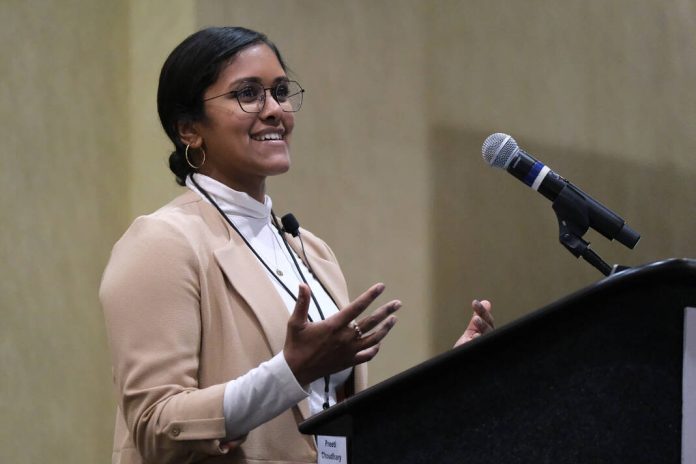
Preeti Choudhary is executive director of DriveOhio, an initiative of the Ohio Department of Transportation that serves as the state’s hub for mobility technology on the ground and in the air.
J.D. Pooley | Sentinel-Tribune
PERRYSBURG — A planned nationwide network of electric vehicle chargers was presented to the Toledo Metropolitan Area Council of Governments during the 2023 General Assembly on Friday.
The event, which was held at the Hilton Garden Inn at Levis Commons, featured keynote speaker Preeti Choudhary, executive director of DriveOhio. She spoke about the investment in electric vehicle infrastructure that will be coming to Ohio through use of funds from the bipartisan infrastructure law.
“With the passage of the bipartisan infrastructure law, they released billions of dollars to fund a baseline network of EV infrastructure across the country. So we have the responsibility of implementing that infrastructure across the country, in accordance with federal guidance,” Choudhary said.
She said that there is $7.5 billion coming from the program for electric vehicle charging. Of those funds, $5 billion is meant for the National EV Infrastructure Formula Program, which would give Ohio $20.7 million per year over the next five years.
The focus of the first phase of the plan will be on alternative fuel corridors along the interstate expressways.
The priority will be on 30 electric vehicle long-range charging stations, placed at 50-mile increments. The second phase will have stations placed on U.S. and state routes. Future phases will be determined by state and local priorities.
The stations would each have four ports for charging with DC Fast Chargers, which provide a full charge in 20 minutes. The stations would have daily 24-hour access, in a format that is to be comparable to fueling a car with gasoline, in a format that would be consistent from state to state.
“The experience should be similar to fueling your car with any other means, so it will be comfortable, publicly accessible, provide amenities and be well lit,” Choudhary said.
She said that automobile manufacturers are now pushing for electrification.
“This is a huge step toward removing the barrier of long-range anxiety that comes with EV driving. This will really build up that backbone in Ohio and across state borders to support folks in removing that barrier and increase adoption in the years to come,” Choudhary said.
Bid awards are to be determined in March, with construction slated to begin in May. The stations should be in place by May 2024.
In other business, TMACOG members met in caucuses to discuss local issues.
The proposed U.S. 23 improvement to Columbus stood out, said Tim Brown, TMACOG president.
“Almost every single breakout caucus, villages, townships, education — all of them — were talking about the very important issue of our connectivity to the interior of the state. We don’t begrudge Delaware County, north of Columbus, its growth, but every time they add a new development and another new stop sign, and then a stop light, it degradates our freight corridor and our connectivity,” Brown said.
Further complicating the Route 23 situation, is the Canadian government investment in creating the new Gordie Howe Bridge, he said. This will connect Windsor, Canada, to Detroit, and allow for additional freight capacity coming from ports in the Carolinas to Canada, through Northwest Ohio.
“Our area will explode with additional freight capacity. We have a bottleneck. It is an artery that is clogged with 38 traffic lights, unlike any other metropolitan area in Ohio, where we have to wade through 38 traffic lights before we make it through the outer belts of Columbus,” Brown said.
For the second time, Bowling Green Mayor Mike Aspacher was elected as TMACOG chair and Perrysburg Mayor Tom Mackin was elected as vice chair.
“There’s been a lot of discussion about the federal bipartisan infrastructure law and what opportunities that is going to create for local communities. Certainly Bowling Green is positioned to benefit from those funds that are going to flow from the federal government down to the local level,” Aspacher said in a followup interview. “It’s really important to me that I’m doing what I can do to represent Bowling Green and make certain that we’re advocating on behalf of the community and make certain that the Bowling Green community can benefit from this really historic opportunity.”
Mackin gave the city caucus report and is taking back several ideas that were discussed in that meeting and he hopes to use the opportunity to work collaboratively with TMACOG members to make them happen.
“There’s lots of access to funds at the state and national level that we could bring to the region and northern Wood County if we collaborate more,” Mackin said. “There’s also the ongoing effort to bring Toledo, Perrysburg and Columbus, through both rail and through the improvements to U.S. 23. It is something that really does have a negative impact on the region and on our state.
Barriers to economic development were also a concern for Mackin. He heard a lot of concerns about state and local government funds and the related regulations that are burdensome for cities, which are then transferred to residents, and he believes in turn hurts small business owners.
“When we see how the different issues go together, we can make is easier to get one-stop shopping for permits at the city and county level. I think that’s something that came through today, is that the barriers to small businesses, through state and local requirements, not always working together, when those work together, it will make it easier for small businesses to get started.”
At the township level, new Perrysburg Township Administrator Jon Eckel participated in the township caucus. Eckel was a previous chairman of the Water Quality Council.
“I’ve been involved in TMACOG for 37 years. It’s about leaving your ego at the door and working on this area as a region,” Eckel said. “At the township caucus I signed up as a trustee and I got back on the Water Quality Council, as a township representative.”




